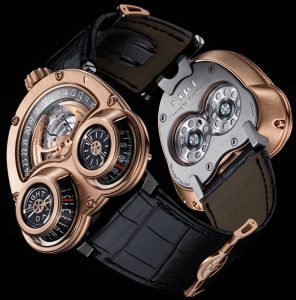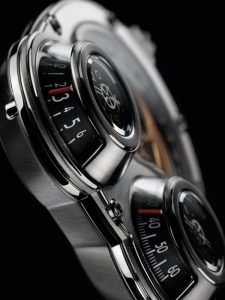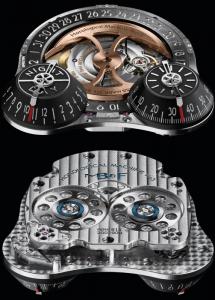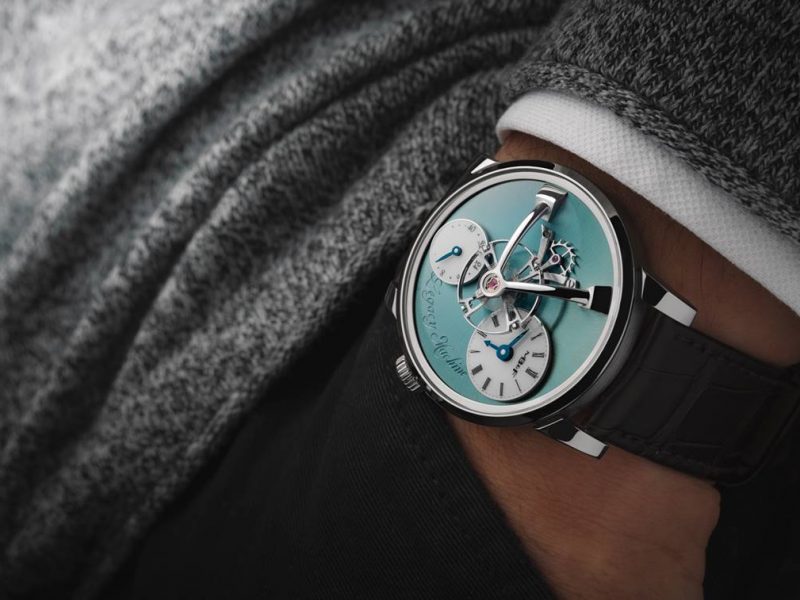MB&F Horological Machine No3
Inspiration and Realization: Horological Machine No3 was developed to display the machine’s beautifully finished movement in operation. Harmoniously crafted bridges, rapidly oscillating balance wheel, gearing and distinctive battle-axe shaped automatic winding rotor are all open to view. This allows the wearer to fully appreciate the art and craft that makes up HM3 and draws the viewer’s gaze inside the highly complex machine; a machine comprising more than 300 fine-finished, high-precision components.
The movement of HM3 has been literally turned upside down to allow for an uninterrupted panorama of the solid gold winding rotor’s graceful arcs and the high-speed oscillations of the balance wheel. Jean-Marc Wiederrecht, winner of the inaugural award for Best Watchmaker at the 2007 Grand Prix d’Horlogerie de Genève, was entrusted with turning the drawings and designs of Max Büsser and designer Eric Giroud into horological reality and, with his team at Agenhor, he not only met but surpassed the challenge.
Starcruiser and Sidewinder: MB&F’s Horological Machines are for individualists who demand art, craft, excellence, exclusivity . . . and choice. To cater to these demanding aficionados, Horological Machine No3 is available in two versions: ‘Sidewinder’, with its cones lined perpendicular to the arm and ‘Starcruiser’, with its cones in line with the arm. Just like their potential owners, each is very special, each is very different.
Indications: The three-dimensional time-indicating cones allow for telling the time at a glance, whether driving or typing; however, the fact that nothing like them had ever been attempted before in horology posed considerable challenges. The top caps of the truncated cones are brazed (not glued) to ensure maximum water-resistance and the red ‘hands’ of the hour and minute indicators had to be cut by laser to obtain the incredibly high precision with minimum mass that the design necessitated.
The over-sized date wheel is actually a larger diameter than the movement, a fact that allows for very legible and well spaced 2.5mm high numbers. A neat triangle engraved into the top of the case marks the date.
Mystery Rotor: the prominence of the 22K solid gold battle-axe shaped rotor on the dial of HM3 is certain to increase the recognition of this already iconic MB&F symbol. The rotor is a ‘mystery’ because it appears to defy the laws of physics in being symmetrically balanced instead of having a visibly off-centred mass. This is achieved by machining the underside of one arm to a razor-thin edge so reducing its mass.
Technical Innovations:
Ceramic Bearings: Time indications are usually located on the top, or dial side, of a movement. As the movement of HM3 is inverted to display its operation, an efficient solution was needed to bring power from the bottom of the movement to the timekeeping cones and date wheel at the top. Standard pinions set in jewels would have required complex, friction-generating gearing, and would require support top and bottom – a factor which would increase the height of the movement, and thus the watch. So instead of standard jewelled pinions, HM3 features two large-diameter (15mm) high-tech ceramic bearings. These minimize the number of gear-wheels (and thus friction) because of their large diameter and, as they only require support at one end (the base) due to the rigidity resulting from their ultra-high precision design and manufacture, they allow for a thinner movement.
Large Date: The over-sized date ring has a diameter larger than the movement. While the design allows for large (2.5mm high) easy-to-read numbers, the considerable distance between each number, while aiding legibility, required great ingenuity in enabling the date to be adjusted. Technical constraints in using the crown to operate the date meant that a pusher was called for; however, a pusher has an approximate travel of only 1mm – far short of the 4mm needed to move the date wheel from one day to the next. An ingenious system of amplifying the pusher’s travel was developed using efficient gearing to multiply by four the distance travelled by the pusher.
Sapphire cones: Three-dimensional cones have never been used to display time before, and no wonder as their manufacture was said to be impossible. Fortunately the impossible just took a little longer. The difficulty lay not in actually fabricating the cones, but in polishing the interior of their (originally) translucent surface until transparent. The caps of the truncated cones are brazed (a high temperature soldering technique) to their gold rims, a technique which is aesthetically pleasing and ensures a solid and waterproof construction.
Screw heads: Perfection lies in the details, form follows function. Those two statements explain both the reason MB&F has gone to the effort of redesigning the slots of the case screws and their unusual cloverleaf shape. Sharp-edge shaped screw slots require sharp-edge shaped screwdrivers, a tool tailor-made for scratching polished gold screws. The rounded cloverleaf pattern in the head of HM3 screws is not only pleasing to the eye, it reduces the chances of damage to the screw. Horological Machines are micro-mechanical works of art and demand that each and every component both looks superb and functions impeccably.
Case and finish: Though totally original in design, the double indications, idiosyncratic play of matt and polished finished surfaces, iconic mystery rotor and slope-sided case ensure that HM3 is unmistakeably, 100 per cent pure Horological Machine.
Technical Specifications
Movement:
Three-dimensional horological engine designed by Jean-Marc Wiederrecht/Agenhor;
Girard-Perregaux oscillator and gear
Balance oscillating at 28,800 bph.
22k rose gold battle-axe shaped ‘mystery’ automatic winding rotor
Hour and minutes information transmitted via ceramic ball bearings to laser-cut hands.
Number of jewels: 36 (all functional)
Number of components: 304
Functions:
Hour and day/night indicator on one cone
Minutes on second cone
Date around the movement
Case:
2 versions: Starcruiser (cones in line with arm)
Sidewinder (cones perpendicular to arm)
Both versions available in 18k white gold/ titanium or 18k red gold/titanium.
Screwed-down crown
Dimensions (exclusive of crown and lugs): 47mm x 50mm x 16mm
Number of case components: 53 – Starcruiser , 57 – Sidewinder
Sapphire crystals:
Cones and both display backs with anti-reflective treatment on both faces.
Strap & Buckle:
Black hand-stitched alligator with 18k gold and titanium custom designed deployment buckle.
‘Friends’ responsible for Horological Machine No3
Concept: Maximilian Büsser/MB&F
Product Design: Eric Giroud – Eric Giroud Design Studio
Technical and Production Management: Serge Kriknoff/MB&F
Movement Development: Jean-Marc Wiederrecht/Agenhor, Nicolas Stalder/Agenhor
Movement manufacturing: Georges Auer/Mecawatch, Salvatore Ferrarotto/APR Quality
Ceramic ball bearings: Patrice Parietti/MPS
Movement assemblage: Didier Dumas/MB&F, Gilles Dalloz/Agenhor
Case and buckle construction and production: Philippe Marti, Dominique Mainier and Stéphane Lhomme of G.F.Châtelain
Sapphire cones: Sébastien Sangsue and Grégory Esseric/Sebal, Peter Bloesch/Bloesch
Dials: François Bernhard and Denis Parel of Nateber
Hands: Pierre Chillier, Isabelle Chillier and Félix Celetta of Fiedler
Strap: Olivier Purnot/Camille Fournet
Presentation case: Frédéric Legendre/Lekoni, Isabelle Vaudaux/Vaudaux






